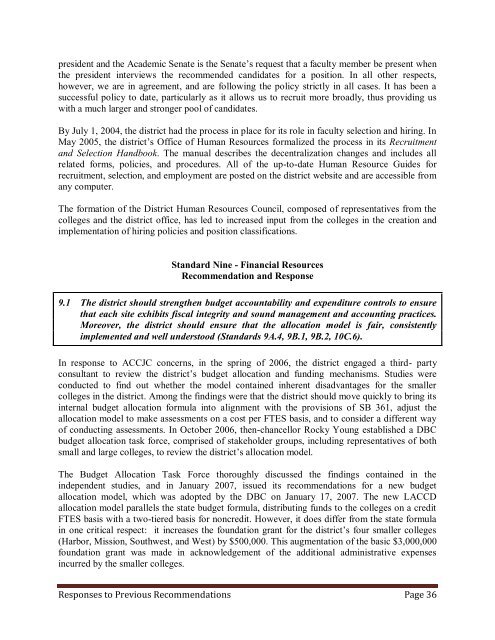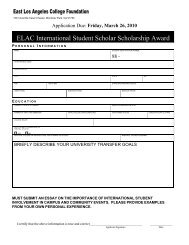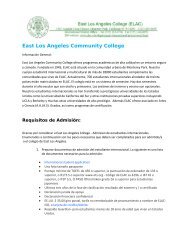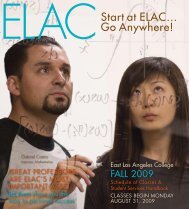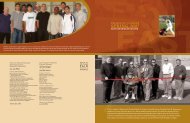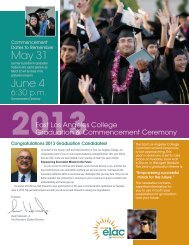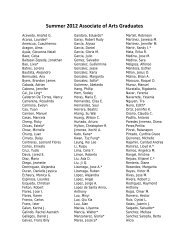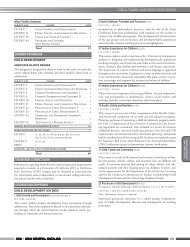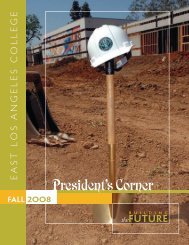Introduction - East Los Angeles College
Introduction - East Los Angeles College
Introduction - East Los Angeles College
Create successful ePaper yourself
Turn your PDF publications into a flip-book with our unique Google optimized e-Paper software.
president and the Academic Senate is the Senate’s request that a faculty member be present when<br />
the president interviews the recommended candidates for a position. In all other respects,<br />
however, we are in agreement, and are following the policy strictly in all cases. It has been a<br />
successful policy to date, particularly as it allows us to recruit more broadly, thus providing us<br />
with a much larger and stronger pool of candidates.<br />
By July 1, 2004, the district had the process in place for its role in faculty selection and hiring. In<br />
May 2005, the district’s Office of Human Resources formalized the process in its Recruitment<br />
and Selection Handbook. The manual describes the decentralization changes and includes all<br />
related forms, policies, and procedures. All of the up-to-date Human Resource Guides for<br />
recruitment, selection, and employment are posted on the district website and are accessible from<br />
any computer.<br />
The formation of the District Human Resources Council, composed of representatives from the<br />
colleges and the district office, has led to increased input from the colleges in the creation and<br />
implementation of hiring policies and position classifications.<br />
Standard Nine - Financial Resources<br />
Recommendation and Response<br />
9.1 The district should strengthen budget accountability and expenditure controls to ensure<br />
that each site exhibits fiscal integrity and sound management and accounting practices.<br />
Moreover, the district should ensure that the allocation model is fair, consistently<br />
implemented and well understood (Standards 9A.4, 9B.1, 9B.2, 10C.6).<br />
In response to ACCJC concerns, in the spring of 2006, the district engaged a third- party<br />
consultant to review the district’s budget allocation and funding mechanisms. Studies were<br />
conducted to find out whether the model contained inherent disadvantages for the smaller<br />
colleges in the district. Among the findings were that the district should move quickly to bring its<br />
internal budget allocation formula into alignment with the provisions of SB 361, adjust the<br />
allocation model to make assessments on a cost per FTES basis, and to consider a different way<br />
of conducting assessments. In October 2006, then-chancellor Rocky Young established a DBC<br />
budget allocation task force, comprised of stakeholder groups, including representatives of both<br />
small and large colleges, to review the district’s allocation model.<br />
The Budget Allocation Task Force thoroughly discussed the findings contained in the<br />
independent studies, and in January 2007, issued its recommendations for a new budget<br />
allocation model, which was adopted by the DBC on January 17, 2007. The new LACCD<br />
allocation model parallels the state budget formula, distributing funds to the colleges on a credit<br />
FTES basis with a two-tiered basis for noncredit. However, it does differ from the state formula<br />
in one critical respect: it increases the foundation grant for the district’s four smaller colleges<br />
(Harbor, Mission, Southwest, and West) by $500,000. This augmentation of the basic $3,000,000<br />
foundation grant was made in acknowledgement of the additional administrative expenses<br />
incurred by the smaller colleges.<br />
Responses to Previous Recommendations Page 36


